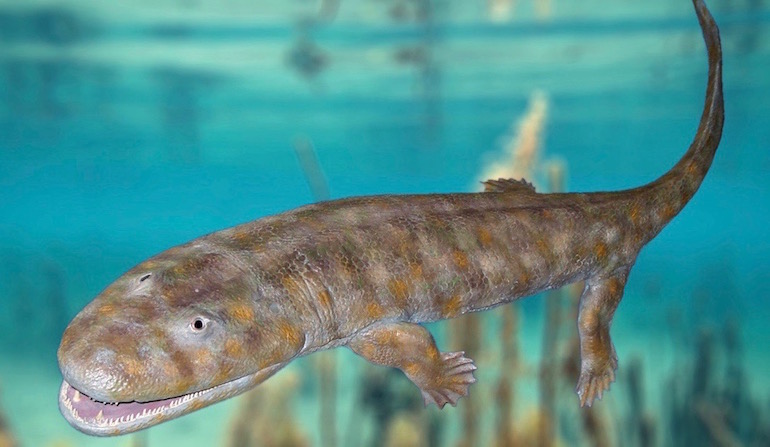 Evolution
Evolution
Did Fish as Flotsam Conquer Land?

In evolutionary biology, the great transitions from one habitat to a totally different way of life have long proved to be the stuff of good storytelling. Based on an old idea from the eminent vertebrate paleontologist Alfred Romer (1933), Balbus (2014) suggested that tidal modulation influenced the evolution from “fish” to tetrapods in the Devonian period. This was supposed to be thanks to a much smaller distance from the Moon to the Earth, causing greater tidal ranges. Balbus (2014) speculated:
The two earliest known tetrapods with more than fragmentary remains, Acanthostega and Ichthyostega, are thought to have been fully (perhaps only predominantly in the case of Ichthyostega) aquatic creatures. The coastal and estuarial waters such organisms and their immediate ancestors are believed to have inhabited would have been subject to sizeable and irregular tides, leaving an inland network of pools. The farthest inland of these pools would on occasion have been left exposed weeks at time, ultimately evaporating. A creature caught in one of these isolated inland pools would consequently have faced dehydration or suffocation.
Now, Witze (2018) reports in Nature News on new results from simulations of the tides in the Devonian by two researchers from Bangor University.
They studied two time periods: 430 million years ago, around the time the first animal lungs evolved, and 400 million years ago, roughly the time of the first known land tetrapods.
What they found were tidal cycles that would have left fish stranded in tidal pools for two weeks.
The team speculates that fish that could have made their way out of the tide pool, and back to the water, would have been more likely to survive. Fossils of some of the earliest known terrestrial tetrapods, such as the Tiktaalik lobe-finned fish from Canada’s Ellesmere Island and trackways in Poland’s Holy Cross mountains, have been found in places that had these high tidal variations.
Well, that sounds interesting, but there are some tiny problems that might spoil this cute hypothesis: Acanthostega and Ichthyostega were actually not marine creatures at all, but strictly confined to freshwater habitats far from the coastline. Balbus (2014) recognized this problem but trivialized it by calling their association with a non-marine inland basin “a more ambiguous tidal zone.” You can’t make such stuff up. What about the famous “missing link,” Tiktaalik? The name Tiktaalik means “big river fish” in the Inuit language and indeed indicates its true provenance. Here is what its discoverer, Neil Shubin, wrote on the official Tiktaalik website:
We know that lobe-finned fish and the first tetrapods lived in freshwater streams because of the sediments we find them in. So we look for freshwater deposits, not marine.
Hmm, but fortunately there are still the Zachelmie trackways discovered a few years ago (Niedźwiedzki et al. 2010) in Poland and dated as not only older than Tiktaalik, but actually older than all other lobe-finned ancestors of tetrapods (the so-called elpistostegids).
These Zachelmie tracks were originally attributed to a marine intertidal depositional environment. So apparently, we have a perfect match of the oldest evidence with the new (old) theory. Indeed, the describers of these tracks also speculated “that the origin of tetrapods occurred, not in the vegetated margins or surrounding seasonal ‘flooded forest’ environments of rivers, as has frequently been argued, but in the marine intertidal and/or lagoonal zone.”
But again, we must spoil the fun: A brand new study by Qvarnström et al. (2018) demonstrates that the Zachelmie locality was misinterpreted in the original description of the tracks and indeed “represents a succession of ephemeral lakes with a restricted and non-marine biota, rather than a marginal marine environment as originally thought.” These tidal pools evaporate in totally unexpected ways, don’t they?
It is true that some elpistostegid lobe-finned fish, which are supposed to belong to the stem of tetrapods and were originally all interpreted as freshwater dwellers, have meanwhile been attributed to brackish estuarine habitats that may have been exposed to tidal influences (Clack 2012). However, the Zachelmie tetrapod tracks are distinctly older than all known elpistostegid fossils and thus cast considerable doubt on the hypothesis that tetrapods really evolved from this group of lobe-finned fish. It’s an inconvenient temporal paradox that is frequently encountered in the fossil record (compare the alleged origin of birds and feathers).
No wonder that Jennifer Clack, a renowned specialist on early tetrapodomorph fossils, remains skeptical about the tidal pool idea: “It’s only one of a plethora of ideas for the origin of land-dwelling tetrapods, any or all of which may have been a part of the answer.” You will not be too far off if you interpret this as meaning: We have no clue!
Literature:
- Balbus SA 2014. “Dynamical, biological, and anthropic consequences of equal lunar and solar angular radii.” Proceedings of the Royal Society A 470: 20140263.
- Clack JA 2012. Gaining Ground: The Origin and Evolution of Tetrapods. Indiana University Press, 523 pp.
- Niedźwiedzki G, Szrek P, Narkiewicz K, Narkiewicz M, Ahlberg PE 2010. “Tetrapod trackways from the early Middle Devonian period of Poland.” Nature 463: 43-48.
- Qvarnström M, Szrek P, Ahlberg PE, Niedźwiedzki G 2018. “Non-marine palaeoenvironment associated to the earliest tetrapod tracks.” Scientific Reports 8: 1074.
- Romer AS 1933. Man and the Vertebrates. University of Chicago Press: Chicago.
- Shubin N 2009. The Search for Tiktaalik. Website by the University of Chicago.
- Witze A 2018. “Ocean tides could have driven ancient fish to walk.” Nature News 15 February 2018.
Image: Acanthostega, reconstruction by Dr. Günter Bechly (Own work) [CC BY-SA 3.0], via Wikimedia Commons.


